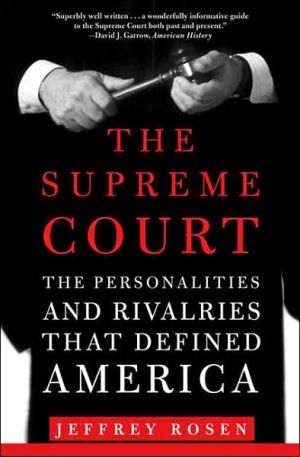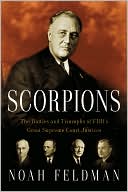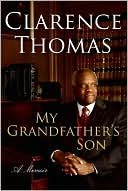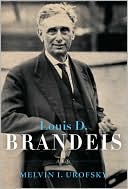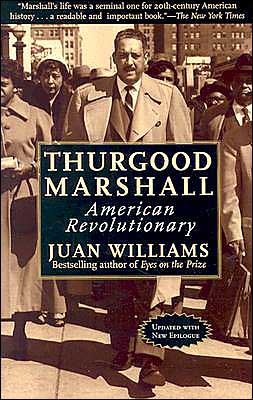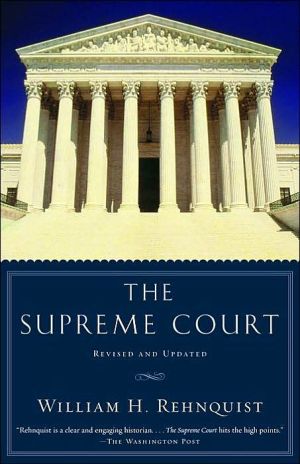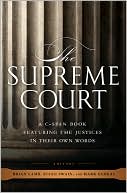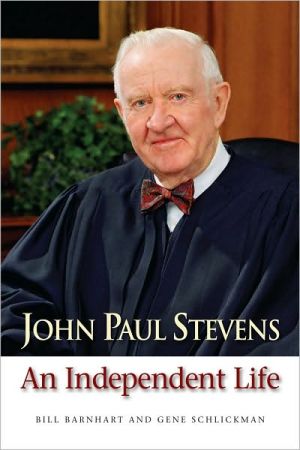The Supreme Court: The Personalities and Rivalries That Defined America
"Superbly well written . . . a wonderfully informative guide to the Supreme Court both past and present."—David J. Garrow, American History Jeffrey Rosen recounts the history of the Supreme Court through the personal and philosophical rivalries that have transformed the law—and by extension, our lives. With studies of four crucial conflicts—Chief Justice John Marshall and President Thomas Jefferson; post-Civil War justices John Marshall Harlan and Oliver Wendell Holmes; liberal icons Hugo...
Search in google:
A leading Supreme Court expert recounts the personal and philosophical rivalries that forged our nation's highest court and continue to shape our daily lives. In this compelling work, Jeffrey Rosen recounts the history of the Court through the personal and philosophical rivalries on the bench that transformed the law and, by extension, our lives. Rosen brings to life the perennial conflict that has animated the Court—between those justices guided by strong ideology and those who forge coalitions and adjust to new realities. Publishers Weekly In his second book this year (after The Most Democratic Branch), Rosen examines how temperament and personal style shape decision making at the U.S. Supreme Court. The author, a law professor and legal affairs editor at the New Republic, profiles four pairs of contrasting personalities: President Thomas Jefferson and Chief Justice John Marshall; Justices Oliver Wendell Holmes and John Marshall Harlan; Justices William O. Douglas and Hugo Black; and finally Justice Antonin Scalia and Chief Justice William Rehnquist. Jefferson, Holmes, Douglas and Scalia are Rosen's exemplars of judicially counterproductive temperaments: they are ideologues, too invested in promoting the purity of their ideas to exert long-term influence on constitutional law. Far more persuasive for Rosen are Marshall, Harlan, Black and Rehnquist, distinguished by collegiality, willingness to compromise and subordinate their own agendas to the prestige of the Court. Most of the book consists of anecdotes about these eight judges, along with summaries of their most celebrated decisions and brief but perceptive explanations of their judicial philosophies. All this is entertaining, although it dilutes the book's stated focus on judicial temperament. Considering today's Court, Rosen believes Chief Justice Roberts will display a successful talent for consensus-building. As Rosen is well aware, a lot rides on the accuracy of this prediction. (Jan.) Copyright 2006 Reed Business Information.
Introduction\ On April 8, 1952, to prevent an imminent steelworkers’ strike that he thought would cut off the flow of guns to U.S. troops in the middle of the Korean War, President Harry S. Truman decided to use his authority as commander in chief to seize the nation’s steel mills. His decision would provoke more criticism than any other in his presidency. But Truman had been emboldened to act in part because of confidential advice from Chief Justice Fred Vinson, whom Truman had appointed to the Supreme Court in 1946. When Truman informed Vinson in advance of his intention to seize the steel mills, the chief justice assured his friend the president that the seizure would be legal under his executive powers and that a majority of the Court would support it. Vinson’s advice turned out to be wrong. In June, two months after the president issued his executive order, the Supreme Court declared in Youngstown Sheet & Tube v. Sawyer that Truman had acted unconstitutionally. Writing for a 6–3 majority, Justice Hugo Black declared that the Constitution gives Congress, not the president, the power to make laws, and Congress had refused to authorize this heavy-handed approach to settling labor disputes. Black read his opinion for the Court from the bench. “Even though ‘theater of war’ be an expanding concept,” he drawled in his calm and deliberate southern accent, “we cannot with faithfulness to our constitutional system hold that the Commander in Chief of the Armed Forces has the ultimate power as such to take possession of private property in order to keep labor disputes from stopping production.” Although an ardent Democrat as well as a former senator, Black revered the institution of the Supreme Court as something larger than the individual justices who composed it, and masterfully persuaded a majority of his colleagues to enforce the limits that the Constitution places on the president’s power. Vinson filed a sputtering dissent insisting that any president worthy of the office should be free to take emergency measures necessary to ensure the “survival of the nation.” Truman was understandably livid at his rebuke by a Court that had been appointed entirely by him or by his Democratic predecessor, Franklin D. Roosevelt. But Black soon made amends by inviting the aggrieved president and the entire Court over to his house in Alexandria, Virginia, for bourbon and a barbecue. As the canapés were passed around, the mollified Truman declared, “Hugo, I don’t much care for your law, but, by golly, this bourbon is good.”1\ Fifty-four years later, a similar drama unfolded at the Supreme Court. President George W. Bush, seeking to protect the nation after the terrorist attacks of September 11, 2001, issued an executive order creating special military commissions to try suspected enemy combatants who were being held at Guantánamo Bay. His decision, combined with other assertions of unilateral presidential power to authorize something close to torture or indefinite detention of suspected terrorists, provoked more criticism than any other in his presidency. Bush had been emboldened to act in part because his legal advisers had assured him that unilateral action would be upheld as constitutional under his powers as commander in chief, and also, perhaps, because the chief justice he had recently appointed, John G. Roberts, Jr., had sustained Bush’s action as an appellate judge. When the Supreme Court heard the case in 2006, Roberts properly recused himself because of his earlier participation in the case, but Bush still had reason for optimism: seven of the nine justices were Republican appointees, including an associate justice appointed by Bush, Samuel A. Alito. In Hamdan v. Rumsfeld, however, by a vote of 5–3, the Supreme Court held that the president’s military commissions were illegal. In his opinion for the Court, Justice John Paul Stevens emphasized that the president could create military commissions only with congressional support, and Congress had refused to give Bush the power to create the military commissions at issue in the case. In an emotional dissenting opinion, which he read aloud from the bench (only the second time he has done so in his fifteen years on the Court), Justice Clarence Thomas declared that the majority had endangered the nation by “sorely hamper[ing] the President’s ability to confront and defeat a new and deadly enemy.” Thomas, like Vinson, insisted that the president’s inherent authority as commander in chief was broad enough to allow him to act unilaterally in times of war.\ The impassioned performances by two justices—Black in 1952, Thomas in 2006—open a window onto the Supreme Court. In many respects, the similarities between Black and Thomas are striking. Both were appointed young to the Court by a president who relished the opportunity to put a stick in the eye of his congressional opponents. Black, a southern white liberal, was Franklin D. Roosevelt’s first appointment after his bitter defeat over expanding the Court’s membership in 1937; Thomas, a southern black conservative, was George H. W. Bush’s choice to replace the civil rights icon Thurgood Marshall in 1991. Both had been on the Court for exactly fifteen years when these cases about presidential power in wartime came before them—long enough to accustom themselves to the Court’s peculiar rituals and to find their jurisprudential voices. And both men considered themselves strict constructionists and constitutional fundamentalists who refused to enforce rights that did not appear explicitly in the Constitution and believed that the constitutional text should be construed in light of the original understanding of its framers and ratifiers.\ Despite these similarities in background and judicial philosophy, Black and Thomas differed in one crucial respect: judicial temperament. Black revered the institution of the Court so passionately that when he proposed marriage to his secretary, Elizabeth (six years after the death of his first wife), he made a little speech about how he had been having a love affair with the Court for almost twenty years, and therefore she had to be, like Caesar’s wife, above reproach: “I have to know that the woman I marry is a one-man woman,” he declared.2 This reverence led him to moderate or to rein in his strict constructionist ideology when he thought the good of the Court and the country required it. As a result, he became one of the most influential justices of his era, redefining large areas of American law in his own image. Thomas, by contrast, is an ideological purist, more interested in being philosophically consistent than in persuading colleagues to embrace his vision. He is so zealous in his devotion to carrying every principle to its logical conclusion that his ideological ally Justice Antonin Scalia told Thomas’s biographer that Thomas would overturn any judicial precedent with which he disagreed, whereas he, Scalia, wouldn’t do that.3 Thomas is underrated as a constitutional lawyer in the popular imagination: his Hamdan opinion, like much of his work, was exhaustively researched, and his colleagues have praised his technical ability in complicated regulatory cases. But because Thomas approaches the law as an essentially academic enterprise, he is content, after fifteen years on the Court, to marginalize himself in lonely dissenting opinions, without any immediate prospect of winning majorities. Even if Thomas had the option of ruling against the president and then inviting him over for drinks in the interest of the Court—a form of interbranch socializing that is no longer thinkable in a post-Watergate age—it seems unlikely he would have the inclination to do so.\ The difference between Black and Thomas shows the importance of judicial temperament on the Supreme Court. Those who have it find that the Court is their oyster; those who do not are often condemned to grumbling on the sidelines. And this has been the story of the Supreme Court from the beginning.\ Copyright © 2007 by Jeffrey Rosen. All rights reserved.
Introduction: A Question of Temperament 1The Virginia Aristocrats John Marshall Thomas Jefferson 23The Legacy of the Civil War John Marshall Harlan Oliver Wendell Holmes, Jr. 71Liberty and License Hugo Black William O. Douglas 127Two Faces of Conservatism William H. Rehnquist Antonin Scalia 177Conclusion: The Future of Temperament 221Cases Cited 241Notes 245Acknowledgments 259Illustration Credits 263Index 265
\ Publishers WeeklyIn his second book this year (after The Most Democratic Branch), Rosen examines how temperament and personal style shape decision making at the U.S. Supreme Court. The author, a law professor and legal affairs editor at the New Republic, profiles four pairs of contrasting personalities: President Thomas Jefferson and Chief Justice John Marshall; Justices Oliver Wendell Holmes and John Marshall Harlan; Justices William O. Douglas and Hugo Black; and finally Justice Antonin Scalia and Chief Justice William Rehnquist. Jefferson, Holmes, Douglas and Scalia are Rosen's exemplars of judicially counterproductive temperaments: they are ideologues, too invested in promoting the purity of their ideas to exert long-term influence on constitutional law. Far more persuasive for Rosen are Marshall, Harlan, Black and Rehnquist, distinguished by collegiality, willingness to compromise and subordinate their own agendas to the prestige of the Court. Most of the book consists of anecdotes about these eight judges, along with summaries of their most celebrated decisions and brief but perceptive explanations of their judicial philosophies. All this is entertaining, although it dilutes the book's stated focus on judicial temperament. Considering today's Court, Rosen believes Chief Justice Roberts will display a successful talent for consensus-building. As Rosen is well aware, a lot rides on the accuracy of this prediction. (Jan.) Copyright 2006 Reed Business Information.\ \ \ \ \ Library JournalThe components of judicial decision making have been covered extensively in academic journals and books. Here, Rosen uses a historical context to examine the influence of judicial temperament on the tenures of some of the most influential Supreme Court justices. The author is a law professor at George Washington University as well as legal affairs editor at the New Republic, but the book is concise and free of legal jargon. In each chapter, Rosen compares and contrasts the personalities and backgrounds of one pair of historical figures, beginning with John Marshall and Thomas Jefferson and ending with current justice Antonin Scalia and the late chief justice William Rehnquist. Rosen's approach to judicial decision making is informative, but it leads to some very pointed and seemingly personal criticism of current justices, particularly Anthony Kennedy. However, this is a minor point in an otherwise solid work. While academic libraries can find more scholarly works, this one will be useful for public libraries wanting to build Supreme Court collections.Political Science—Becky Kennedy\ \ \ Kirkus ReviewsAuthoritative analysis of how the justices' "quirks of personality and temperament" have shaped American law and made the Court one of our strongest institutions. Rosen (Law/George Washington Univ.; The Naked Crowd, 2004, etc.) traces the Court's evolution through the stories of four pairs of personalities and their clashes over important issues. The most successful justices, he argues, have been "institutionalists": effective leaders and consensus-builders who are modest, likable, able to find common ground and more concerned about the legitimacy of the Court than their own interests and agendas. The least successful justices have been insecure, heavy-handed "loners" more interested in personal glory than in quietly getting things done. Specialists will appreciate Rosen's examinations of these conflicting judicial temperaments at play during different periods in history; general readers without a solid grounding in constitutional issues may feel lost. The basic differences animating these clashing duos are made clear. Crafty and appealing Chief Justice John Marshall managed time after time to outfox his introverted, thin-skinned political opponent, Thomas Jefferson. Gregarious Justice John Marshall Harlan won out on the issue of majority rule over darker, more ideological Justice Oliver Wendell Holmes, Jr. The persuasive Hugo Black, deeply devoted to the institution of the Court, proved far more influential on key issues than undisciplined, self-destructive William O. Douglas. Of modern conservative justices, Rosen finds that the pragmatic William H. Rehnquist was much more respected within the Court than Antonin Scalia, a rigid purist. A concluding chapter based on an interview withChief Justice John G. Roberts, Jr. suggests that he may have the temperament of his successful predecessors. An illuminating look at the human side of the highest court.\ \
